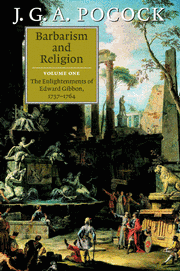Book contents
- Frontmatter
- Contents
- Acknowledgements
- Note on references, quotations and translations
- List of abbreviations
- Introduction
- PART I ENGLAND AND SWITZERLAND, 1737–1763
- PART II THE ENCOUNTER WITH PARIS AND THE DEFENCE OF ERUDITION, 1761–1763
- PART III LAUSANNE AND ROME: THE JOURNEY TOWARDS A SUBJECT, 1763–1764
- Epilogue: Gibbon and the rhythm that was different
- List of references
- Index
Epilogue: Gibbon and the rhythm that was different
Published online by Cambridge University Press: 15 December 2009
- Frontmatter
- Contents
- Acknowledgements
- Note on references, quotations and translations
- List of abbreviations
- Introduction
- PART I ENGLAND AND SWITZERLAND, 1737–1763
- PART II THE ENCOUNTER WITH PARIS AND THE DEFENCE OF ERUDITION, 1761–1763
- PART III LAUSANNE AND ROME: THE JOURNEY TOWARDS A SUBJECT, 1763–1764
- Epilogue: Gibbon and the rhythm that was different
- List of references
- Index
Summary
From Rome – and from excursions to Naples and Venice – Gibbon returned to Hampshire by way of Paris, where he spent a fortnight in the company of both Madame Bontemps and Madame Necker, as Suzanne Curchod had by now become. There is little sign that he renewed his explorations of the société des gens de lettres, and he did not visit Paris again until 1777, or Lausanne until 1783. From 1765 begins the middle period of Gibbon's life, during which the Decline and Fall took shape and half of it was written. These eighteen years present many problems to the critic, biographer and historian, not least because we are no longer informed by journals in which Gibbon recorded his doings, readings and reflections; there are only a number of historical essays, not always easy to date, what can be learned from his letters, and the Decline and Fall itself. The years from 1765 to 1766, when the first volume of his history appeared, have been dubbed ‘Gibbon's dark ages’, not only because the formation of his project and intentions is ill documented and obscure to us, but because it may – as the Memoirs sometimes indicate – have been obscure to Gibbon himself. Some generalisations are, however, permissible.
- Type
- Chapter
- Information
- Barbarism and Religion , pp. 292 - 308Publisher: Cambridge University PressPrint publication year: 1999



